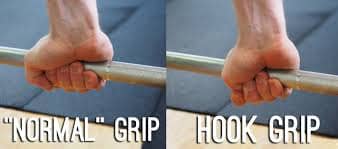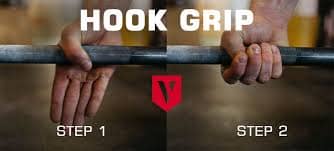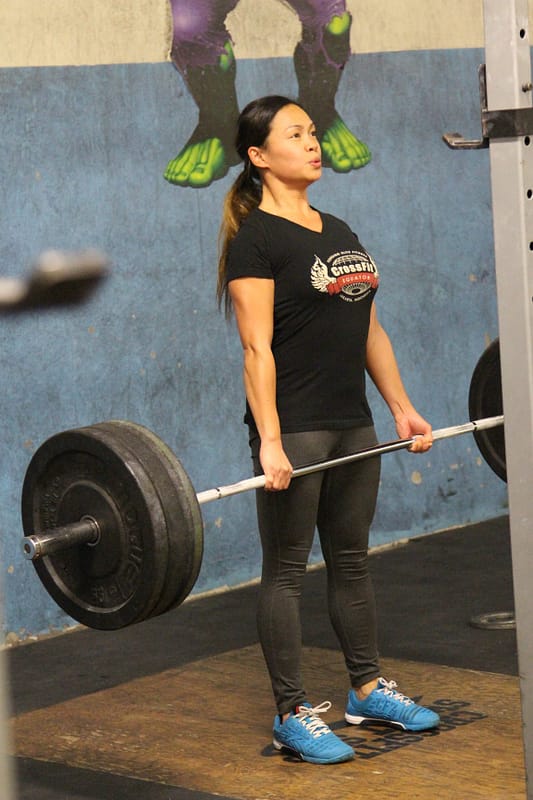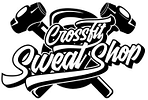To Hook Grip or not to Hook Grip?
When it comes to the Olympic Weightlifting movements (the Snatch and Clean & Jerk) the grip you utilize can seriously affect the amount of weight you are able to lift. For the Snatch and Clean and Jerk most people start of with the normal overhand grip (refer below). As lifters progress and start to get a better comprehension of the movement, coaches will encourage them to utilize the “hook grip.” Now before you go off and tell me that its uncomfortable and you can’t do it because it hurts your thumbs just hear me out! When I first started coming to the Sweat Shop I had never even heard of a hook grip, and I was resistant at first to use it because it was uncomfortable. After Getting used to the hook grip I noticed how much easier the olympic style lifts were and how much easier higher repetition barbell work was. Just think back to when you first started CrossFit and your hands were getting used to all of the bar work we do. Eventually the hands adapt and now you do not even think twice about grabbing a barbell or hopping on a pull up bar. So if you are not already utilizing the hook group I would highly encourage you to stick with it for at least a month! You will not regret it! But don’t just take it from me, check out this post below that Jared Enderton (a successful weightlifter and CrossFit athlete) made about why YOU should use the hook grip.

The hook grip is when you take the index and middle finger and wrap it over the thumb instead of directly around the bar. There are a couple of advantages of using the hook grip versus the standard overhand grip. The first and most apparent once you try it is that holding onto the bar is a lot less taxing. The bar is hooked in your hand instead of being squeezed by your hands. You’ll notice how much less tension is in your forearm when yo u use the hook grip. This can really come in handy because normally when you use the standard overhand grip the bar will feel like it is going to come out of the hands as you’re pulling the bar off the ground. This is because the bar will rotate towards the thumb and end up stressing the grip and upper back muscles. This can easily pull you out of position and make the lift harder, which will in turn limit the amount of weight you can lift. When using the hook grip, your hand is “hooked into” place, so the rotation will not effect your lifting ability nearly as much because it is in a much more supported position. To reiterate, you will be able to lift more while stressing less muscles, sounds like a win win to me!
u use the hook grip. This can really come in handy because normally when you use the standard overhand grip the bar will feel like it is going to come out of the hands as you’re pulling the bar off the ground. This is because the bar will rotate towards the thumb and end up stressing the grip and upper back muscles. This can easily pull you out of position and make the lift harder, which will in turn limit the amount of weight you can lift. When using the hook grip, your hand is “hooked into” place, so the rotation will not effect your lifting ability nearly as much because it is in a much more supported position. To reiterate, you will be able to lift more while stressing less muscles, sounds like a win win to me!

Someone who uses the hook grip on a regular basis (even for her benchpress!!) is Rowena.
Another advantage of the hook grip is its use for high rep barbell work and even ends up being a saving grace for many. Lets say you have a workout where you have to do a lot of hang cleans and toes to bar, talk about a grip blowout! If you use the normal overhand grip on the hang clean you will notice how quickly your forearms get taxed and you’ll be shakin those things out constantly to get that cement feeling out of your forearms. If you utilize the hook grip on the hang cleans you’ll notice how much less taxing the hang cleans are on your grip and you can greatly lessen the chance of being limited by your grip. The only consideration you have to have when using the hook grip for high rep barbell movements is that most people will need to release the hook grip in the rack and overhead position. Very few people have the flexibility to maintain this grip and holding the hook grip when receiving the barbell can stress the hands and be uncomfortable. If you plan on employing the hook grip during higher rep work, try to learn how to release and catch the hook grip to avoid the above problems.
Using the hook grip can be very beneficial to improving your lifts and also taking the stress off of the forearms. In saying that, you do not want to be completely reliant on the hook grip. From time to time it is still a good idea to train without using the hook grip to ensure that you retain and keep building both your grip and upper back strength. As with anything you never want to become completely reliant on it, so foregoing the hook grip from time to time is also a good strategy to employ. As always if you have questions about how or when to use the hook grip please ask any of the coaches we are more than happy to help!
https://www.instagram.com/p/BfJg6T0FLUR/?hl=en&taken-by=jaredenderton




Leave a Reply
Want to join the discussion?Feel free to contribute!